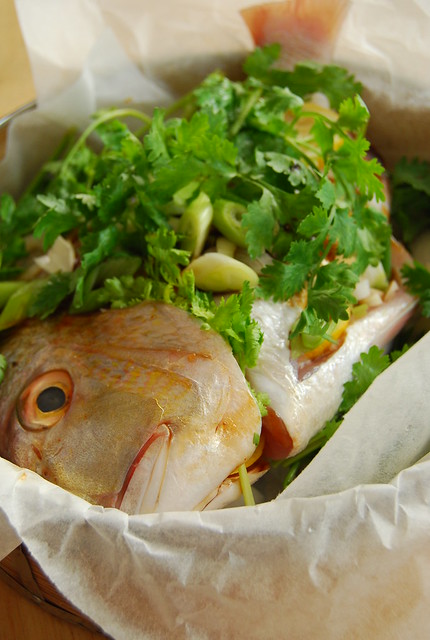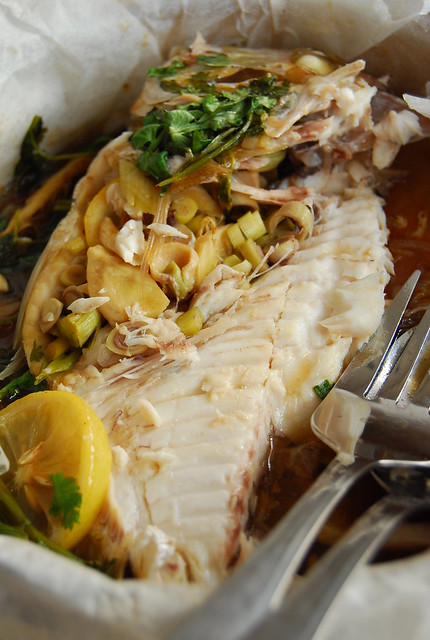
I grew up eating fish whole, on the bone. Small fish, like tilapia or galunggong (mackarel scad), simply fried and eaten with soy sauce or vinegar. Bigger fish, like lapu lapu (grouper) or apahap (sea bass), baked or steamed for special occasions. Oh sure, we also had fish in fillets and steaks (fillets I like, but I mysteriously cannot abide by steak cut fish), but there was something special about having a whole fish. To this day I prefer whole fish over fillets and other cuts.
I love the simple perfection of a fish rubbed with salt and then fried exactly right, the outside and edges crisp, the inside tender and moist, eaten hot and with my hands. Maybe with a dipping sauce of vinegar with just a touch of soy and some crushed bird’s eye chilies…or maybe not. I work through it precisely but slowly, savoring every bite, missing nothing. When I’m done there is nothing left but a pile of clean bones that not even a skilled cat could get more out of.
This is another wonderful way to have whole fish. Healthier too, but no less delicious :)
Steamed Fish, Asian Style
- One whole 3/4-kilo (approx) Bisugo (threadfin bream), Maliputo, or Lapu-lapu (garoupa), scaled and gutted
- 1-inch piece of ginger, peeled and sliced
- Half a lemon, sliced
- 1 white onion, sliced
- 2 stalks of lemongrass, white and light green parts only, sliced
- 2 leeks, white and light green parts only, sliced on the diagonal
- 1 bunch of cilantro
- Optional: 1 cilantro root (if the bunch of cilantro you use has them, and it should)
- 1-2 tablespoons fish sauce
- 3-4 tablespoons soy sauce
- 1 tablespoons sesame oil
- Line a bamboo steamer with parchment so it comes up over the sides. Line the parchment with the onion slices, some ginger slices, and one slice of lemon. Lay your fish on top of these aromatics. Stuff the inside of the fish (inside the belly as well as inside the head) with most of the remaining ginger and lemon, lemongrass, some of the leeks, a few stalks of cilantro, and cilantro root. Top the fish with any ginger and lemon you have left, the rest of the leeks, and the most of the cilantro (saving a few stalks to garnish fresh once the fish is cooked). Top everything with the soy sauce, fish sauce, and sesame oil. I’ve made the amounts above flexible as this really depends on your taste and the size of your fish. Fold sides of parchment over the fish – it doesn’t have to cover it completely – and cover.
- While you are arranging your fish, fill a wok with enough water not to touch the steamer when you lay it inside. Cover and bring to a boil, then lower to a fast simmer.
- When the fish is ready and the water in the wok is at a fast simmer, carefully place steamer on the wok.
- Steam fish for about 20 minutes. You may need more or less time depending on the size of your fish so check for doneness before taking it off the heat. Simply open the steamer (carefully! Steam burns!), and insert a small knife into the fleshiest part of the fish – if it flakes easily it’s done.
- Turn of the heat and remove the bamboo steamer from the wok – do this carefully with your hands protected as very hot steam will escape when you lift the steamer from the wok. Place the steamer on a plate and serve directly! Tear the remaining cilantro over the newly cooked fish.

This is my basic framework for our favorite Asian-style steamed fish. The fish stays moist and the aromatics infuse it with their crisp, fresh flavors. The soy, fish sauce, and sesame oil pool below the fish where the onions have gone all melty to make a delicious sauce. This recipe is adaptable and forgiving. Add, take away, or replace some of the herbs as you like (not everyone is a cilantro junkie like me I suppose) or as available (I’m going to try a version with Kaffir lime leaves and Thai basil next!). Use your favorite fish or try a new one from the market. Fillets would work here as well, although I implore you to try this with fresh whole fish as there is really nothing quite like it!